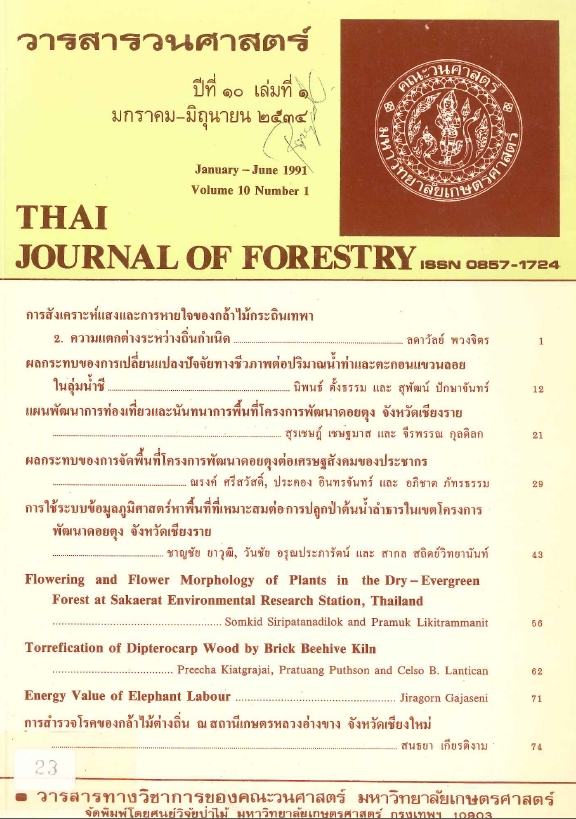ผลกระทบของการเปลี่ยนแปลงปัจจัยทางชีวภาพต่อปริมาณน้ำท่าและตะกอนแขวนลอยในลุ่มน้ำชี
Main Article Content
บทคัดย่อ
ผลกระทบของการเปลี่ยนแปลงสภาพชีวกายภาพรวมทั้งการทำลายป่าและการทำการเกษตรที่มีผลต่อปริมาณของคุณภาพของน้ำท่าได้มีการวิพากษ์วิจารณ์กันอยู่ตลอดมา การศึกษาครั้งนี้ต้องการจะทราบว่าการบุกเบิกพื้นที่ป่าเพื่อใช้ที่ดินทำการเกษตรในภาคตะวันออกเฉียงเหนือของประเทศไทย จะส่งผลอย่างไรในเรื่องดังกล่าว จึงได้ใช้ลุ่มน้ำย่อยจำนวน 11 ลุ่มน้ำของลุ่มน้ำชีเป็นตัวแทนในการศึกษาภายใต้สมมติฐานที่ว่าลักษณะทางกายภาพของพื้นที่ เช่นขนาดพื้นที่ลุ่มน้ำ ความลาดชันเฉลี่ยของพื้นที่ อัตราส่วนความต่างระดับของลำน้ำ ปริมาณฝน สัดส่วนของชั้นคุณภาพลุ่มน้ำ และการเปลี่ยนแปลงสภาพป่าเพื่อทําการเกษตรจะส่งผลต่อความผันแปรของน้ำท่าและตะกอนแขวนลอย โดยเฉพาะการทําลายป่าจะมีผลทำให้ปริมาณตะกอนแขวนลอยและน้ำท่ามากขึ้น ซึ่งผลการศึกษาจากการใช้ข้อมูล แผนที่ป่าไม้จากกรมป่าไม้ ข้อมูลน้ำท่าและตะกอนของกรมชลประทานและการพลังงานแห่งชาติในช่วงปี พ.ศ. 2505 ถึง 2527 ทำการวิเคราะห์ในเชิงสถิติ พบว่าปริมาณฝนและสัดส่วนของลุ่มน้ำชั้นที่ 3 มีผลต่อปริมาณน้ำท่าและตะกอนอย่างมีนัยสำคัญยิ่งทางสถิติ ส่วนการทำลายป่านั้นแม้ว่าจะไม่แสดงอิทธิพลต่อน้ำท่าและตะกอนแขวนลอยอย่างมีนัยสำคัญทางสถิติ แต่มีแนวโน้มบอกให้ทราบว่าเมื่อพื้นที่ป่าลดน้อยถอยลงทุก ๆ 10 เปอร์เซ็นต์ของพื้นที่ลุ่มน้ำจะทำให้มีน้ำท่าในลุ่มน้ำเพิ่มขึ้น 37 ล้าน ลบ.ม. / ปี และตะกอนแขวนลอยเพิ่มขึ้น 6,672 ตัน / ปีในกรณีที่พื้นที่ลุ่มน้ำมีอ่างเก็บน้ำอยู่ด้วยเมื่อพื้นที่ป่าไม้ลดลงปริมาณน้ำท่าจะเพิ่มขึ้นทั้งในช่วงฤดูแล้งและฤดูฝนส่วนพื้นที่ลุ่มน้ำที่ไม่มีอ่างเก็บน้ำ ปริมาณน้ำท่าจะเพิ่มขึ้นเฉพาะในฤดูฝนเท่านั้น
Downloads
Article Details

อนุญาตภายใต้เงื่อนไข Creative Commons Attribution-NonCommercial-NoDerivatives 4.0 International License.
ข้าพเจ้าและผู้เขียนร่วม (ถ้ามี) ขอรับรองว่า ต้นฉบับที่เสนอมานี้ยังไม่เคยได้รับการตีพิมพ์และไม่ได้อยู่ในระหว่างกระบวนการพิจารณาตีพิมพ์ลงในวารสารหรือสิ่งตีพิมพ์อื่นใด ข้าพเจ้าและผู้เขียนร่วม (ถ้ามี) ยอมรับหลักเกณฑ์และเงื่อนไขการพิจารณาต้นฉบับ ทั้งยินยอมให้กองบรรณาธิการมีสิทธิ์พิจารณาและตรวจแก้ต้นฉบับได้ตามที่เห็นสมควร พร้อมนี้ขอมอบลิขสิทธิ์ผลงานที่ได้รับการตีพิมพ์ให้แก่วารสารวนศาสตร์ คณะวนศาสตร์ มหาวิทยาลัยเกษตรศาสตร์ กรณีมีการฟ้องร้องเรื่องการละเมิดลิขสิทธิ์เกี่ยวกับภาพ กราฟ ข้อความส่วนใดส่วนหนึ่ง หรือ ข้อคิดเห็นที่ปรากฏในผลงาน ให้เป็นความรับผิดชอบของข้าพเจ้าและผู้เขียนร่วม (ถ้ามี) แต่เพียงฝ่ายเดียว และหากข้าพเจ้าและผู้เขียนร่วม (ถ้ามี) ประสงค์ถอนบทความในระหว่างกระบวนการพิจารณาของทางวารสาร ข้าพเจ้าและผู้เขียนร่วม (ถ้ามี) ยินดีรับผิดชอบค่าใช้จ่ายทั้งหมดที่เกิดขึ้นในกระบวนการพิจารณาบทความนั้น”


